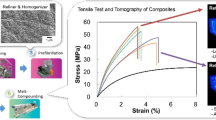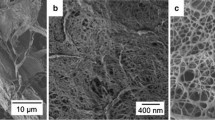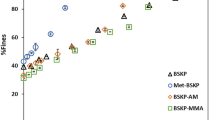Abstract
Microfibrillated cellulose (MFC), a mechanically fibrillated pulp mostly consisting of nanofibrils, is a very attractive material because of its high elastic modulus and strength. Although much research has been done on composites of MFC and polypropylene (PP), it has been difficult to produce such composites at an industrial level because of the difficulties in using MFC in such composites are not only connected to the polarity (that can be improved with compatibilizers), but also with the challenge to make a homogeneous blend of the components, and also the low temperature stability of cellulose that could cause problems during processing. We developed a new processing method which enables continuous microfibrillation of pulp and its melt compounding with PP. Never-dried kraft pulp and powdered PP were used as raw materials to obtain MFC by kneading via a twin-screw extruder. Scanning electron microscopy showed nano to submicron wide fibers entangled in the powdered PP. MFC did not aggregate during the melt compounding process, during which the water content was evaporated. Maleic anhydride polypropylene (MAPP) was used as a compatibilizer to reinforce interfacial adhesion between the polar hydroxyl groups of MFC and non-polar PP. We investigated the effect of MAPP content on the mechanical properties of the composite, which were drastically improved by MAPP addition. Needle-leaf unbleached kraft pulp (NUKP)-derived MFC composites had better mechanical properties than needle-leaf bleached kraft pulp (NBKP)-derived MFC composites. Injection molded NUKP-derived MFC composites had good mechanical and thermal properties. The tensile modulus of 50 wt% MFC composite was two times, and the tensile strength 1.5 times higher than that of neat PP. The heat distortion temperature of 50 wt% MFC content composite under 1.82 MPa flexural load was increased by 53 °C, from 69 to 122 °C. This newly developed continuous process using powder resin has the potential for application at an industrial level.








Similar content being viewed by others
References
Abe K, Iwamoto S, Yano H (2007) Obtaining cellulose nanofibers with a uniform width of 15 nm from wood. Biomacromolecules 8(10):3276–3278. doi:1021/bm700624p
Chakraborty A, Sain M, Kortschot M (2006) Reinforcing potential of wood pulp-derived microfibres in a PVA matrix. Holzforschung 60:53–68. doi:https://doi.org/10.1515/HF.2006.010
Chattopadhyay SK, Khandal RK, Uppaluri R, Ghoshal AK (2011) Bamboo fiber reinforced polypropylene composites and their mechanical, thermal, and morphological properties. J Appl Polym Sci 119(3):1619–1626. doi:https://doi.org/10.1002/app.32826
Chinga-Carrasco G (2011) Cellulose fibres, nanofibrils and microfibrils: the morphological sequence of MFC components from a plant physiology and fibre technology point of view. Nanoscale Res Lett 6(1):417. doi:https://doi.org/10.1186/1556-276X-6-417
Duchesne I, Hult EL, Molin U, Daniel G, Iversen T, Lennholm H (2001) The influence of hemicellulose on fibril aggregation of kraft pulp fibres as revealed by FE-SEM and CP/MAS 13C-NMR. Cellulose 8(2):103–111
Eichhorn SJ, Dufresne A, Aranguren M, Marcovich NE, Capadona JR, Rowan SJ, Weder C, Thielemans W, Roman M, Renneckar S et al (2010) Review: current international research into cellulose nanofibres and nanocomposites. J Mater Sci 45(1):1–33. doi:https://doi.org/10.1007/s10853-009-3874-0
Felix JM, Gatenholm P (1991) The nature of adhesion in composites of modified cellulose fibers and polypropylene. J Appl Polym Sci 42(3):609–620. doi:https://doi.org/10.1002/app.1991.070420307
Haydaruzzaman KhanAH, Hossain MA, Khan MA, Khan RA, Hakim MA (2010) Fabrication and characterization of jute reinforced polypropylene composite: effectiveness of coupling agents. J Compos Mater 44(16):1945–1963. doi:https://doi.org/10.1177/0021998309356604
Hult EL, Larsson PT, Iversen T (2001) Cellulose fibril aggregation—an inherent property of kraft pulps. Polymer 42(8):3309–3314. doi:https://doi.org/10.1016/S0032-3861(00)00774-6
Iwamoto S, Nakagaito AN, Yano H (2007) Nano-fibrillation of pulp fibers for the processing of transparent nanocomposites. Appl Phys A Mater Sci Process 89(2):461–466. doi:https://doi.org/10.1007/s00339-007-4175-6
Iwamoto S, Abe K, Yano H (2008) The effect of hemicelluloses on wood pulp nanofibrillation and nanofiber network characteristics. Biomacromolecules 9(3):1022–1026. doi:https://doi.org/10.1021/bm701157n
Iwatake A, Nogi M, Yano H (2008) Cellulose nanofiber-reinforced polylactic acid. Compos Sci Technol 68(9):2103–2106. doi:https://doi.org/10.1016/j.compscitech.2008.03.006
Jonoobi M, Harun J, Mathew AP, Oksman K (2010) Mechanical properties of cellulose nanofiber (CNF) reinforced polylactic acid (PLA) prepared by twin screw extrusion. Compos Sci Technol 70(12):1742–1747. doi:https://doi.org/10.1016/j.compscitech.2010.07.005
Klemm D, Kramer F, Moritz S, Lindström T, Ankerfors M, Gray D, Dorris A (2011) Nanocelluloses: a new family of nature-based materials. Angew Chem 50(24):5438–5466. doi:https://doi.org/10.1002/anie.201001273
Lee SY, Chun SJ, Doh GH, Kang IA, Lee S, Paik KH (2009) Influence of chemical modification and filler loading on fundamental properties of bamboo fibers reinforced polypropylene composites. J Compos Mater 43(15):1639–1657. doi:https://doi.org/10.1177/0021998309339352
Ljungberg N, Cavaillé J-Y, Heux L (2006) Nanocomposites of isotactic polypropylene reinforced with rod-like cellulose whiskers. Polymer 47(18):6285–6292. doi:https://doi.org/10.1016/j.polymer.2006.07.013
Mathew AP, Oksman K, Sain M (2005) Mechanical properties of biodegradable composites from poly lactic acid (PLA) and microcrystalline cellulose (MCC). J Appl Polym Sci 97(5):2014–2025. doi:https://doi.org/10.1002/app.21779
Nakagaito AN, Yano H (2004) The effect of morphological changes from pulp fiber towards nano-scale fibrillated cellulose on the mechanical properties of high-strength plant fiber based composites. Appl Phys A 78(4):547–552. doi:https://doi.org/10.1007/s00339-003-2453-5
Nakagaito AN, Yano H (2005) Novel high-strength biocomposites based on microfibrillated cellulose having nano-order-unit web-like network structure. Appl Phys A 80(1):155–159. doi:https://doi.org/10.1007/s00339-003-2225-2
Nakatani H, Iwakura K, Hamadate M, Okazaki N, Aoyama M, Terano M (2011) Interface adhesion properties of syndiotactic polypropylene/cellulose group composite: relationship between chemical structure of coupling agent and reactivity for cellulose group. J Appl Polym Sci 122(4):2798–2806. doi:https://doi.org/10.1002/app.34325
Nishino T, Matsuda I, Hirao K (2004) All-cellulose composite. Macromolecules 37(20):7683–7687. doi:https://doi.org/10.1021/ma049300h
Oksman K, Clemons C (1998) Mechanical properties and morphology of impact modified polypropylene–wood flour composites. J Appl Polym Sci 67(9):1503–1513
Osman H, Ismail H, Mustapha M (2010) Effects of maleic anhydride polypropylene on tensile, water absorption, and morphological properties of recycled newspaper filled polypropylene/natural rubber composites. J Compos Mater 44(12):1477–1491. doi:https://doi.org/10.1177/0021998309359212
Page DH, El-Hosseiny F (1983) The mechanical properties of single wood pulp fibres. J Pulp Paper Sci September:99–100
Qiu W, Endo T, Hirotsu T (2004) Interfacial interactions of a novel mechanochemical composite of cellulose with maleated polypropylene. J Appl Polym Sci 94(3):1326–1335. doi:https://doi.org/10.1002/app.21123
Qiu W, Zhang F, Endo T, Hirotsu T (2005) Effect of maleated polypropylene on the performance of polypropylene/cellulose composite. Polym Compos 26(4):448–453. doi:https://doi.org/10.1002/pc.20119
Qiu W, Endo T, Hirotsu T (2006) Interfacial interaction, morphology, and tensile properties of a composite of highly crystalline cellulose and maleated polypropylene. J Appl Polym Sci 102(4):3830–3841. doi:https://doi.org/10.1002/app.24846
Sakurada I, Nukushina Y, Ito T (1962) Experimental determination of the elastic modulus of crystalline regions in oriented polymers. J Polym Sci 57(165):651–660. doi:https://doi.org/10.1002/pol.1962.1205716551
Samir MASA, Alloin F, Paillet M, Dufresne A (2004) Tangling effect in fibrillated cellulose reinforced nanocomposites. Macromolecules 37(11):4313–4316. doi:https://doi.org/10.1021/ma035939u
Siró I, Plackett D (2010) Microfibrillated cellulose and new nanocomposite materials: a review. Cellulose 17:459–494. doi:https://doi.org/10.1007/s10570-010-9405-y
Suryanegara L, Nakagaito AN, Yano H (2009) The effect of crystallization of PLA on the thermal and mechanical properties of microfibrillated cellulose-reinforced PLA composites. Compos Sci Technol 69(7–8):1187–1192. doi:https://doi.org/10.1016/j.compscitech.2009.02.022
Suryanegara L, Nakagaito AN, Yano H (2010) Thermo-mechanical properties of microfibrillated cellulose-reinforced partially crystallized PLA composites. Cellulose 17:771–778. doi:https://doi.org/10.1007/s10570-010-9419-5
Suryanegara L, Okumura H, Nakagaito AN, Yano H (2011) The synergetic effect of phenylphosphonic acid zinc and microfibrillated cellulose on the injection molding cycle time of PLA composites. Cellulose 18:689–698. doi:https://doi.org/10.1007/s10570-011-9515-1
Sykacek E, Grzeskowiak B, Edlhofer G, Mundigler N (2011) Improvement in impact-, tensile-, and dynamic properties of injection molded wheat-pulp-polypropylene composites through fiber finishing. J Appl Polym Sci 122(4):2697–2707. doi:https://doi.org/10.1002/app.34308
Zimmermann T, Pöhler E, Geiger T (2004) Cellulose fibrils for polymer reinforcement. Adv Eng Mater 6(9):754–761. doi:https://doi.org/10.1002/adem.200400097
Acknowledgments
We thank Professor Fumiaki Nakatsubo of the Faculty/Graduate School of Agriculture, and Doctor Kentaro Abe, Kyoto University, for advice concerning this research. This study was supported by the Industrial Technology Research Grant Program of the New Energy and Industrial Technology Development Organization (NEDO), Japan, Oji Holdings Corporation, Mitsubishi Chemical Corporation, DIC Corporation, Seiko PMC Corporation, Nippon Paper Chemicals Co., Ltd., Nippon Paper Industries Co., Ltd., and Sumitomo Rubber Industries.
Author information
Authors and Affiliations
Corresponding author
Rights and permissions
About this article
Cite this article
Suzuki, K., Okumura, H., Kitagawa, K. et al. Development of continuous process enabling nanofibrillation of pulp and melt compounding. Cellulose 20, 201–210 (2013). https://doi.org/10.1007/s10570-012-9843-9
Received:
Accepted:
Published:
Issue Date:
DOI: https://doi.org/10.1007/s10570-012-9843-9




